- Tutorials
- Blocks ( 막기 makgi )
- Outside Block ( 바깥막기 momtong-bakkat-makgi )
Taekwondo 태권도Taekwondo Preschool
When you reach senior belt you are expected to guide the junior belts when they are beginning Taekwondo such as showing by example. To advance from one rank to the next, students typically complete promotion tests in which they demonstrate their proficiency in the various aspects of the art before a panel of judges or their teacher. View Taekwondo belt levels »




Outside Middle Block
바깥막기 momtong-bakkat-makgi
Difficulty Level: Intermediate Technique: Blocks ( 막기 makgi )
An Outside Middle Block ( 바깥막기 momtong-bakkat-makgi ) deflects a strike away from the defender leaving an opportunity for a counterattack. For example, against a straight punch ( 지르기 jireugi ) to the chest area, an Outside Middle Block ( 바깥막기 momtong-bakkat-makgi ) would aim to meet the forearm of the attacker, pushing the punch ( 지르기 jireugi ) outwards causing it to miss, and then most commonly leaving the defender slightly to the side to counterattack the opponent.
To begin the technique, the practitioner would cross their forearms at shoulder height level with the palms ( 손바닥 sonbadak ) facing the face. The intended blocking arm would be further away from the body on the outside during the moment the forearms are crossed in front of the face; if blocking with the left arm the right hand is closer to the face. With the punch ( 지르기 jireugi ) approaching, the practitioner would then block outwards pushing the strike away from the defender. The other hand is chambered immediately to the waist for a counterattack strike such as a punch ( 지르기 jireugi ).
Remember to twist your body when you make the block ( 막기 makgi ) and keep the wrists ( 팔목 palmok ) straight. Another important thing to remember is that the Outside Middle Block ( 바깥막기 momtong-bakkat-makgi ) is moving in a straight line across the chest while blocking. The other hand on the waist usually acts as a preparation move for a follow up technique such as a counter punch. Practitioners may combine techniques in a series to ensure one or more strikes impact their opponents.
Typically because of the angles involved, the Outside Middle Block ( 바깥막기 momtong-bakkat-makgi ) is used to block ( 막기 makgi ) against attacks aimed at the torso. Most critical organs are housed within the torso. For example, in the upper chest, the heart and lungs are protected by the rib cage, while the abdomen contains the stomach, kidney, and etc. The technique could also be used to block ( 막기 makgi ) the upper section with the High Outside Block ( 올려 바깥막기 olgul-bakkat-makgi ).
Training Methods
How well one improves with training depends on several factors, such as the frequency it is engaged in, and the type of feedback that is available for improvement. If a student does not train often enough, reinforcement fades, and he or she is likely to forget what was learned.
When learning the block ( 막기 makgi ), it is helpful to use mirrors to observe your technique and fix your mistakes immediately. Initially, a student may need focused feedback from a certified Master Instructor ( 사범님 sabeomnim ); however, as they progress, they must develop the ability to self-assess the block ( 막기 makgi ).
The technique is also learned by blocking in the air as though there is an opponent striking but focusing on the form, speed, and technique; then moving on to partner training (self-defence scenarios, sparring practices, one-step sparring, etc) reinforcing the block ( 막기 makgi ) on a realistic moving attack.
Difficulty of Technique
Taekwondo students of geup ranking learn the most basic techniques first, and then move on to more advanced and difficult techniques as they approach 1st Dan Black Belt. The more difficult the technique, the more practice may be needed for the purpose of improving or mastering it, as in the phrase 'practice makes perfect'. Every technique must display the requisite speed, balance, power and firmness to be realistically used as an attack or defense move.
* Please see a certified Master Instructor ( 사범님 sabeomnim ) for training. Proper guidance and instructions are needed to ensure safe training.
Promotion Tests
Students often undergo periodic testing and grading by their own Master Instructor ( 사범님 sabeomnim ) in order to advance to a higher level of recognized achievement such as a different belt color. They need to demonstrate their proficiency in the various aspects of the art such as the execution of patterns ( 품새 poomse ), which combine various techniques in specific sequences.
Outside Middle Block ( 바깥막기 momtong-bakkat-makgi ) is a requirement for the below belt levels (Techniques vary between schools). Promotion from one belt level to the next can proceed rapidly in some schools, since schools often allow geup promotions every two, three, or four months. Students of geup rank learn the most basic techniques first, and then move on to more advanced techniques as they approach first dan black belt. View Promotion Tests »
Advertisement

Did you know?
Taekwondo Summer Olympic Games

Taekwondo became a full medal sport at the 2000 Summer Olympics in Sydney, Australia, and has been a sport in the Olympic games since then. For Olympic competition, there will be a single elimination tournament for each of the weight categories. Repechage competition will occur for the bronze medal contest, while the winner of the tournament will receive the gold medal, and the loser will receive the silver medal. For more information View Taekwondo Summer Olympic Games »
| Year | Date | Flag | City | Host Country |
| 2020 |  |
Tokyo | Japan | |
| 2016 | August 5 -August 21 |  |
Rio de Janeiro | Brazil |
| 2012 | July 27 - August 12 |  |
London | United Kingdom |
| 2008 | August 8 - August 24 |  |
Beijing | China |
| 2004 | August 13 - August 29 |  |
Athens | Greece |
| 2000 | September 15 - October 1 |  |
Sydney | Australia |
RESOURCES
This article uses material from the Wikipedia article "Taekwondo at the Summer Olympics" which is released under the Creative Commons Attribution-Share-Alike License 3.0.
Outside Middle Block ( 바깥막기 momtong-bakkat-makgi )
Blocking Surface
Various surfaces of the body may be engaged as the blocking surface depending on which area of the body is being targeted. This leads to a large array of blocking positions. For more information on Impact Surface Areas »
( Click image for additional information)
Technique Injuries
Collisions with the ground, objects, and other taekwondo practitioners are common, and unexpected dynamic forces on limbs and joints can cause injury. Taekwondo injuries can also occur in techniques if done improperly or from overuse of a particular body part. Taking a break from training or reducing the volume and the intensity of the training will allow the body to recover. For more information on Injuries »
( Click image for additional information)
Common Mistakes when Performing the Technique
When performing the technique, there will be more mistakes as a beginner and as the practitioner advances through the rankings, they will have learned and improved from the past. How well one improves with training depends on several factors, such as the frequency it is engaged in, and the type of feedback that is available for improvement.
( Click image for additional information)
Some Technique(s) to Block Against
Blocking ( 막기 makgi ) is the act of stopping or deflecting an opponent's attack for the purpose of preventing injurious contact with the body in either sparring ( 겨루기 gyeorugi ) or for self-defense ( 호신술 hosinsool ) applications. Experienced practitioners learn through repetition and muscle memory when (not just how) to launch particular blocks ( 막기 makgi ), based on the circumstances they are facing.
( Click image for additional information)
Some Counterstrike Combinations after the Block ( 막기 makgi )
After a successful block ( 막기 makgi ) the taekwondo practitioner may immediately counterattack to the opponent with a kick ( 차기 chagi ) or punch ( 지르기 jireugi ). When the opponent is attacking, they may leave themselves vulnerable in some areas such as recovering from a technique, positioning, imbalance, and more. Practitioners may combine techniques in a series to ensure one or more strikes impact their opponents.
( Click image for additional information)
Some Stance(s) ( 서기 sogi ) used with this Block ( 막기 makgi )
An example of the union of mental and physical discipline is the combination of stance ( 서기 sogi ), footwork ( 딛기 ditgi ), and technique (either with kick, block and/or strike), which requires both physical mastery of the technique and the concentration to focus one's power. Experienced practitioners learn through repetition and muscle memory when (not just how) to launch particular techniques, based on the circumstances they are facing.
( Click image for additional information)
Outside Middle Block ( 바깥막기 momtong-bakkat-makgi )
Use in Sparring ( 겨루기 gyeorugi )
Under World Taekwondo (WT) and Olympic rules, sparring is a full-contact event and takes place between two competitors in an area measuring 8 meters square. A win can occur by points, or if one competitor is unable to continue (knockout) the other competitor wins. Points are awarded for permitted, accurate, and powerful techniques to the legal scoring areas; light contact does not score any points. For more information on World Taekwondo (WT) Tournament Sparring » 
The Outside Middle Block ( 바깥막기 momtong-bakkat-makgi ) is used during sparring competitions to block ( 막기 makgi ) any incoming middle punches ( 몸통 지르기 momtong-jireugi ) to the chest protector ( 호구 hogu ). The chest protector ( 호구 hogu ) is the most common scoring area in taekwondo sparring ( 겨루기 gyeorugi ). The blue or red colored area of the body protector is the scoring targets.
Understanding the tradeoff between power, balance, speed, and footwork ( 딛기 ditgi ) is important in making the appropriate decisions to adjust to each moment is key. Taekwondo students must learn how to deal with a fast, powerful, and determined attacker. It forces the student to improvise, to think under pressure, and to keep their emotions under control.
( Click image for additional information)
Use in Self-Defense ( 호신술 hosinsool ) Applications
Self-Defense is to protect yourself from being attacked from would-be aggressors. It is a countermeasure that involves defending the health and well-being of oneself from harm and is designed primarily to cause injury or quickly incapacitate an attacker, in addition to being a deterrent against them. Attackers are typically larger, stronger, and are often armed or have an accomplice. With proper execution attackers may be incapacitated with a single blow, which lessens the number of attacks with multiple people. For more information on Self-Defense ( 호신술 hosinsool ) »
Each technique must be correctly timed and aligned in order to defend effectively. Taekwondo practitioners must have their body weight correctly distributed during the stance ( 서기 sogi ) including proper footwork ( 딛기 ditgi ). The block ( 막기 makgi ) is performed during Self-Defense ( 호신술 hosinsool ) scenarios.
( Click image for additional information)
Use in One-Step Sparring
One-Step Sparring is performed with a partner in which predefined movements are practiced. One student is the attacker while the other student responds with defenses, counterattacks, and/or other actions, based on part of the predefined movements. For more information on One-Step Sparring »
The block ( 막기 makgi ) is featured during One-Step Sparring practice. Fundamentally, taekwondo One-Step Sparring is one of the learning grounds for real combat. As such, every technique including stance ( 서기 sogi ) must display the requisite speed, power and firmness to be realistically used as an attack or defense move. One-Step Sparring varies between schools.
( Click image for additional information)
Use in Breaking ( 격파 gyeokpa )
The discipline of destroying inanimate objects such as wooden boards, baseball bats, ice blocks or cement bricks and is a feature common to martial arts including taekwondo. A single board or stack of boards may be broken or, alternatively, a series of boards may be broken in a pre-set sequence utilizing a variety of strikes. Advanced competitors may even break several boards in a single jump with multiple kicks before landing. For more information on Breaking ( 격파 gyeokpa ) »
In use, the block ( 막기 makgi ) is not featured during Breaking ( 격파 gyeokpa ) events. General qualities that judges look for in any taekwondo practitioner include proper breathing technique and body control. The diaphragm must be engaged in deep breathing, shallow breathing concentrated in the upper abdomen results in raised shoulders and stressed muscles. Breaking ( 격파 gyeokpa ) varies between schools.
( Click image for additional information)
Advertisement
Outside Middle Block ( 바깥막기 momtong-bakkat-makgi )
Use in Patterns ( 품새 poomse )
Block is introduced in the following patterns:
Poomse is the foundation for the teaching of taekwondo. A poomse or form is a detailed pattern of defense-and-attack motions and techniques used in traditional martial arts. Poomse is useful in developing proper kinetics, mental and physical fortitude.
( Click image for additional information)
Most Kukkiwon 국기원 schools will use the poomse taegeuk whereas a few schools will use the poomse palgwe. The meanings, trigrams and symbols are shared by both poomse taegeuk and poomse palgwe, however the sequence of movements is different. The first 8 forms of the set of poomse differ from each other, whereas the last 9 forms (Black Belt forms) of the set are shared between the two sets. All students studying in World Taekwondo (WT) Kukkiwon style must learn these forms, or taegeuk, to advance to a higher belt level. There are eight taegeuk forms, each one similar to the previous one, but each time with more complicated techniques to display the students' mastery of the techniques learned during lessons, as well as the ability to interconnect these techniques.
For more information on taekwondo patterns refer to Poomse 품새 Section »
Learn other taekwondo blocks on the Main Blocking ( 막기 makgi ) Section »
Experienced practitioners learn through repetition and muscle memory when (not just how) to launch particular blocks, based on the circumstances they are facing. Fights and fighters may have ebbs and flows in momentum and action that become predictable. Disrupting this flow may give the striker an advantage.
Use in Demonstrations
To promote taekwondo for its emphasis on high kicking and fast hand techniques, taekwondo schools perform at tournaments, community events, shopping malls, parks, and tv shows. Demonstrations vary from school to school, but may include such elements as the execution of poomse ( 품새 poomse ), which combine various techniques in specific sequences; the breaking of boards to demonstrate the ability to use techniques with both power and control; sparring ( 겨루기 gyeorugi ) and self-defense ( 호신술 hosinsool ) to demonstrate the practical application and control of techniques; physical fitness usually with push-ups and sit-ups. For more information on Demonstrations »
The block ( 막기 makgi ) is commonly used in demonstration activities such as when performing poomse ( 품새 poomse ) which is the foundation for the teaching of taekwondo. A poomse ( 품새 poomse ) is a series of movements linked together in a prescribed sequence which is significant to demonstrate. As such, every technique must display the requisite speed, power and firmness to be realistically used as an attack or defense move.
( Click image for additional information)
Use in Warming-Up
A warm-up generally consists of a gradual increase in intensity in physical activity, joint mobility exercise, and stretching, followed by the activity. Warming-up brings the body to a condition at which it safely responds to nerve signals for quick and efficient action. For more information on Warming-Up »
In addition to being a block ( 막기 makgi ) in itself, the block ( 막기 makgi ) is an exercise used by many instructors to teach the principle of focusing, stretching, relaxing the muscles, increasing the range of motion and flexibility, something which is considered important in taekwondo. The result is a feeling of increased muscle control, flexibility and range of motion.
( Click image for additional information)
Outside Middle Block ( 바깥막기 momtong-bakkat-makgi )

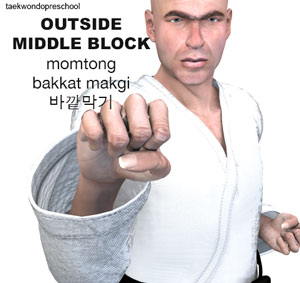
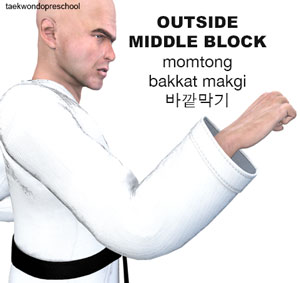
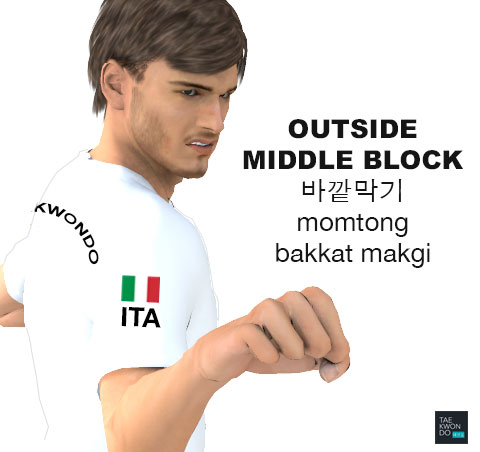
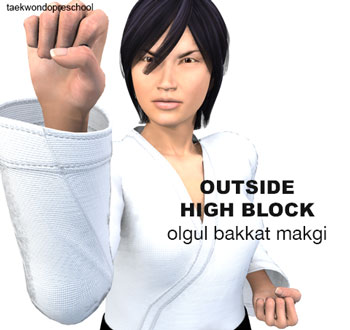
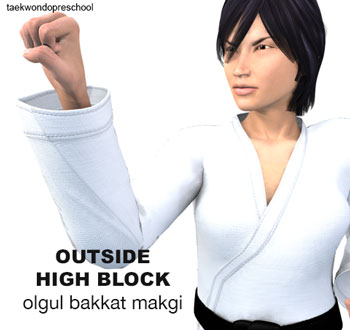
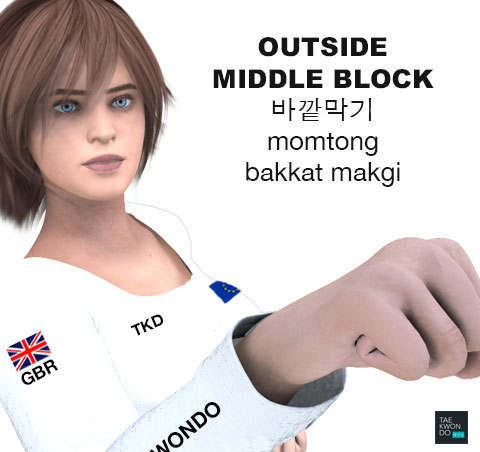
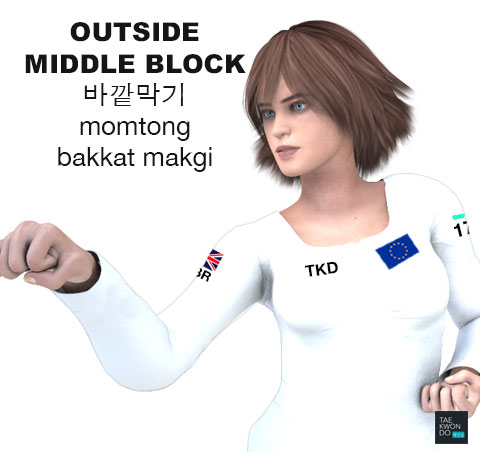

Training Highlights Summary
The Outside Middle Block ( 바깥막기 momtong-bakkat-makgi ) contains many key point highlights. There are some that are simple and straightforward but then some are complex and detailed that require repeated training to learn and master.
- deflects a strike away from the defender leaving an opportunity for a counterattack
- to begin the technique, the practitioner would cross their forearms at shoulder height level with the palms ( 손바닥 sonbadak ) facing the face
- other hand is chambered immediately to the waist for a counterattack strike such as a punch ( 지르기 jireugi )
Precision of Blocking ( 막기 makgi ) Technique
Depending on the strike, one may block ( 막기 makgi ) an attack most commonly by placing a limb across the line of the attack. Some techniques can block and deflect an attack with more precision which allows an effective counterstrike. The below is an approximate measurement of how precise the block requires from the practitioner to be effective.
Experienced practitioners learn through repetition and muscle memory when (not just how) to launch particular blocks ( 막기 makgi ), based on the circumstances they are facing.
* Please see a certified Master Instructor ( 사범님 sabeomnim ) for training. Proper guidance and instructions are needed to ensure safe training.
Additional Resources
Taekwondo Blocks ( 막기 makgi )
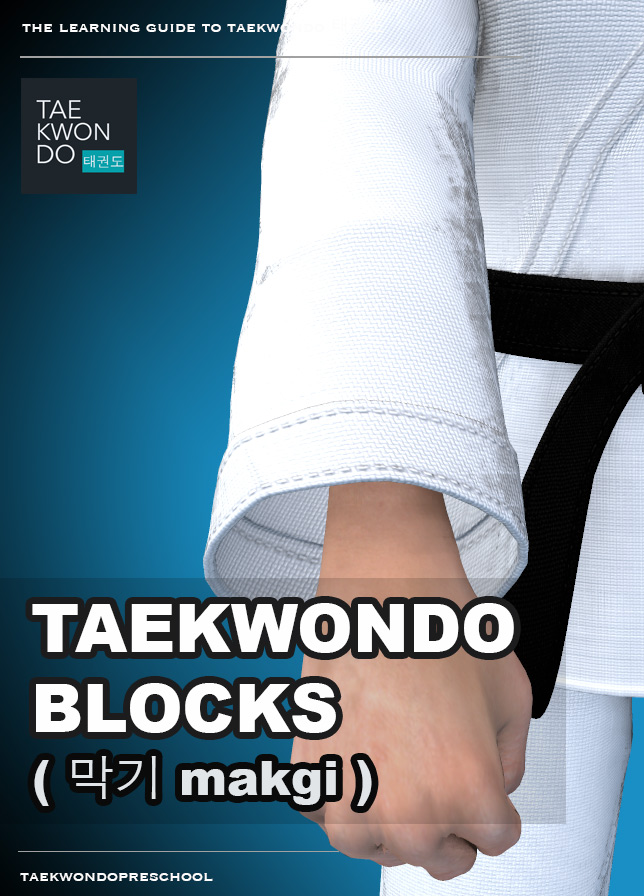
This book is available for download with Apple Books on your Mac or iOS device, and with iTunes on your computer. Book can be read with Apple Books on your Mac or iOS device.
In taekwondo and other martial arts, blocking ( 막기 makgi ) is the act of stopping or deflecting an opponent's attack for the purpose of preventing injurious contact with the body. A block ( 막기 makgi ) usually consists of placing a limb across the line of the attack. Blocks ( 막기 makgi ) are considered by some to be the most direct and least subtle of defensive techniques.
View more information about Book »
TAEKWONDO BLOCKS ( 막기 makgi ) |
|||||
| Hangul 한글 | Korean | Belt Requirement | Difficulty Level | Tutorial | |
| Low Block | 아래막기 | arae-makgi |    |
Beginner Level | Tutorial » |
| Middle Block | 몸통막기 | momtong-makgi |    |
Beginner Level | Tutorial » |
| High Block | 올려막기 | olgul-makgi |    |
Beginner Level | Tutorial » |
| Inner Wrist Outer Block | 안팔목 바깥막기 | anpalmok-bakkat-makgi |   |
Intermediate Level | Tutorial » |
| Single Knife Hand Outward Block | 한손날 바깥막기 | hansonnal-bakkat-makgi |   |
Intermediate Level | Tutorial » |
| Low Side Block | 아래 옆막기 | arae-yeop-makgi |   |
Intermediate Level | Tutorial » |
| Hand Blade Low Block | 한손날 아래막기 | sonnal-arae-makgi |   |
Intermediate Level | Tutorial » |
| Supported Hand Blade Block | 손날 거들어 바깥막기 | sonnal-kodureo-makgi |    |
Intermediate Level | Tutorial » |
| Pressing Block | 눌러막기 | nulleo-makgi |    |
Intermediate Level | Tutorial » |
| Palm Heel Pressing Block | 바탕손 눌러막기 | batangson-nulleo-makgi |    |
Intermediate Level | Tutorial » |
| Outside Wrist Pressing Block | 바깥팔목 눌러막기 | bakkatpalmok-nulleo-makgi |    |
Intermediate Level | Tutorial » |
| Outside Block | 바깥막기 | bakkat-makgi |    |
Intermediate Level | Tutorial » |
| High Outside Block | 올려 바깥막기 | olgul-bakkat-makgi |   |
Intermediate Level | Tutorial » |
| Trunk Push Low Block | 아래 헤쳐막기 | arae-hecho-makgi |  |
Intermediate Level | Tutorial » |
| Cross Block | 엇걸어막기 | otgoreo-makgi |  |
Intermediate Level | Tutorial » |
| Low Cross Blocking | 아래 엇걸어막기 | arae-otgoreo-makgi |  |
Intermediate Level | Tutorial » |
| High Cross Blocking | 올려 엇걸어막기 | olgul-otgoreo-makgi |  |
Intermediate Level | Tutorial » |
| Hand Blade High Cross Block | 손날 엇걸어막기 | sonnal-olgul-otgoreo-makgi |  |
Intermediate Level | Tutorial » |
| Inward Knife Hand Block | 손날 안막기 | sonnal-an-makgi |   |
Intermediate Level | Tutorial » |
| Palm Heel Inward Block | 바탕손 안막기 | batangson-an-makgi |   |
Intermediate Level | Tutorial » |
| Supported Downward Hand Blade Block | 손날 거들어 내려막기 | sonnal-kodureo-naeryeo-makgi |   |
Intermediate Level | Tutorial » |
| Hand Blade Twisting Outward Block | 손날 비틀어 바깥막기 | sonnal-bakkat-bitureo-makgi |   |
Intermediate Level | Tutorial » |
| Palm Heel Assisted Block | 바탕손 거들어 몸통막기 | batangson-kodureo-momtong-makgi |   |
Intermediate Level | Tutorial » |
| Trunk Push Double Block | 헤쳐막기 | hecho-makgi |   |
Intermediate Level | Tutorial » |
| Outside Wrist Double Block | 바깥팔목 헤쳐막기 | bakkat-palmok-hecho-makgi |   |
Intermediate Level | Tutorial » |
| Inside Wrist Double Block | 안팔목 헤쳐막기 | anpalmok-hecho-makgi |   |
Intermediate Level | Tutorial » |
| Side Block | 옆막기 | yeop-makgi |   |
Intermediate Level | Tutorial » |
| Inside Wrist Side Block | 안팔목 옆막기 | anpalmok-yeop-makgi |   |
Intermediate Level | Tutorial » |
| Outside Wrist Side Block | 바깥팔목 옆막기 | bakkat-palmok-yeop-makgi |   |
Intermediate Level | Tutorial » |
| Hand Blade Side Block | 손날 옆막기 | sonnal-yeop-makgi |   |
Intermediate Level | Tutorial » |
| Scissors Blocking | 가위막기 | kawi-makgi |    |
Advanced Level | Tutorial » |
| Supported Trunk Block | 거들어막기 | momtong-kodureo-makgi |  |
Advanced Level | Tutorial » |
| Outside Wrist Supporting Outward Block | 바깥팔목 거들어 바깥막기 | bakkatpalmok-kodureo-bakkat-makgi |  |
Advanced Level | Tutorial » |
| Supported Downward Block | 거들어 내려막기 | kodureo-naeryeo-makgi |  |
Advanced Level | Tutorial » |
| Hand Blade Double Block | 손날 헤쳐막기 | sonnal-hecho-makgi |   |
Advanced Level | Tutorial » |
| Single Hand Wide Open Block | 외산틀막기 | wesanteul-makgi |   |
Advanced Level | Tutorial » |
| Wide Open Mountain Block | 산틀막기 | santeul-makgi |  |
Advanced Level | Tutorial » |
| Diamond Blocking | 금강막기 | keumgang-makgi |  |
Advanced Level | Tutorial » |
| Keumgang Downward Side Block | 금강 내려 옆 막기 | keumgang-naeryeo-yeop-makgi |  |
Advanced Level | |
| Keumgang Outward Block | 금강 바깥막기 | keumgang-bakkat-makgi |  |
Advanced Level | |
| Hand Blade Diamond Downward Side Block | 손날 금강 내려 옆 막기 | sonnal-keumgang-naeryeo-yeop-makgi |  |
Advanced Level | |
| Hand Blade Diamond Outward Block | 손날 금강 바깥막기 | sonnal-keumgang-bakkat-makgi |  |
Advanced Level | |
| Bent Wrist Outward Block | 굽힌손목 바깥막기 | gupinsonmok-bakkat-makgi |  |
Advanced Level | Tutorial » |
| Bull Horn Blocking | 황소막기 | hwangso-makgi |  |
Advanced Level | Tutorial » |
| Ridgehand Outward Block | 손날등 바깥막기 | sonnal-deung-bakkat-makgi |  |
Advanced Level | Tutorial » |
| Ridgehand Side Block | 손날등 옆막기 | sonnal-deung-yeop-makgi |  |
Advanced Level | Tutorial » |
| Ridgehand Double Block | 손날등 헤쳐막기 | sonnal-deung-hecho-makgi |  |
Advanced Level | Tutorial » |
| Ridgehand Supported Downward Block | 손날등 거들어 내려막기 | sonnal-deung-kodureo-naeryeo-makgi |  |
Advanced Level | Tutorial » |
| Inner Wrist Supporting Side Block | 안팔목 거들어 옆막기 | anpalmok-kodureo-yeop-makgi |  |
Advanced Level | Tutorial » |
| Inner Wrist Supporting Outward Block | 안팔목 거들어 바깥막기 | anpalmok-kodureo-bakkat-makgi |  |
Advanced Level | Tutorial » |
| Palm Assisting Outer Block | 손바닥 거들어 바깥막기 | sonbadak-kodureo-bakkat-makgi |  |
Advanced Level | Tutorial » |
| Target Block | 표적 막기 | pyojeok-makgi |  |
Advanced Level | Tutorial » |
| Underneath Target Block | 아래 표적 막기 | arae-pyojeok-makgi |  |
Advanced Level | Tutorial » |
| Kicking Block | 차막기 | cha-makgi |  |
Advanced Level | Tutorial » |
| Outward Kicking Block | 바깥 차막기 | bakkat-cha-makgi |  |
Advanced Level | Tutorial » |
| Inward Kicking Block | 안 차막기 | an-cha-makgi |  |
Advanced Level | Tutorial » |
| Front Kicking Block | 앞 차막기 | ap-cha-makgi |  |
Advanced Level | Tutorial » |
| Side Kicking Block | 옆 차막기 | yeop-cha-makgi |  |
Advanced Level | Tutorial » |
Advertisement

Quiz
Question. What is the korean terminology for Attention Stance?
Attention is a stance ( 서기 sogi ) where your body is in an upright standing position with the legs side by side, heels touching, distribute 50/50 weight ratio on the left and right legs, and toes facing straight forward. Your hands should be parallel with your body, to the side as your hands tap the legs.
What is the korean terminology for Attention Stance?
Answer you gave was: ( 그만 keu-man )
Your answer is wrong! You need to study more!
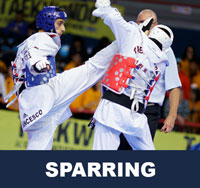

Keu-man ( 그만 ) means to stop a sparring match or poomse. Sparring is a full-contact event and takes place between two competitors in an area measuring 8 meters square. A poomse or form is a detailed pattern of defense-and-attack motions and techniques used in traditional martial arts. Poomse is the foundation for the teaching of taekwondo.
View Korean Terminology »
What is the korean terminology for Attention Stance?
Answer you gave was: ( 차렷 charyeot )
Your answer is correct! Great Job!


Attention is a stance where your body is in an upright standing position with the legs side by side, heels touching, toes facing straight forward. From this stance instructors explain what will be taught during the class session and/or if they want your attention they say Charyeot, meaning you stop whatever you are doing and get into the stance awaiting further instructions. This is the stance ( 서기 sogi ) that all bows ( 경례 gyeong-nye ) come from and is one of the most basic techniques to learn when starting taekwondo as a beginner.
What is the korean terminology for Attention Stance?
Answer you gave was: ( 기합 kihap )
Your answer is wrong! You need to study more!
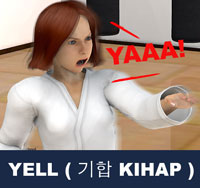

Kihap 기합 is a korean term used in taekwondo which is commonly referred to as a shout or yell made before, during, or after a technique. There are numerous examples of this battle cry in other martial arts: kihap is perhaps primarily a development of this. Students also use kihap to startle an opponent, intimidate, express confidence, or express victory in sparring competitions, self-defense ( 호신술 hosinsool ), or breaking ( 격파 gyeokpa ) applications.
View Yell ( 기합 kihap ) »
What is the korean terminology for Attention Stance?
Answer you gave was: ( 경례 gyeong-nye )
Your answer is wrong! You need to study more!
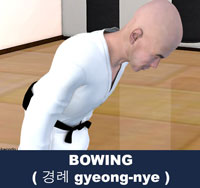

Bowing ( 경례 gyeong-nye ) is the act of lowering the torso and head as a gesture in direction to another person (Master Instructor 사범님 sabeomnim ) or symbol (flag). Bowing is an integral part of traditional martial arts such as Taekwondo. Bows are used to begin and end practice, sparring bouts and competitions, and when entering and leaving the dojang, or practice room.
Question. What year was Taekwondo an official Olympic Demonstration Sport in Seoul, Korea?
Taekwondo made its first appearance at the Summer Olympic Games as a demonstration sport at the Summer Olympics in Seoul, South Korea. The opening ceremony featured a mass demonstration of taekwondo with hundreds of adults and children performing moves in unison. Taekwondo was again a demonstration sport at the Summer Olympics in Barcelona, Spain. There were no demonstration sports at the Summer Olympics in Atlanta, USA.
What year was Taekwondo an official Olympic Demonstration Sport in Seoul, Korea?
Answer you gave was: 1992
Your answer is wrong! You need to study more!


In 1982, taekwondo was designated an official demonstration sport for the 1988 Olympic Games in Seoul, Korea, and for the 1992 Olympic Games in Barcelona, Spain. Taekwondo made its first appearance at the Summer Olympic Games as a demonstration sport at the 1988 Summer Olympics in Seoul, South Korea. The opening ceremony featured a mass demonstration of taekwondo with hundreds of adults and children performing moves in unison.
View Olympic Games »
What year was Taekwondo an official Olympic Demonstration Sport in Seoul, Korea?
Answer you gave was: 1988
Your answer is correct! Great Job!


In 1982, taekwondo was designated an official demonstration sport for the 1988 Olympic Games in Seoul, Korea, and for the 1992 Olympic Games in Barcelona, Spain. Taekwondo made its first appearance at the Summer Olympic Games as a demonstration sport at the 1988 Summer Olympics in Seoul, South Korea. The opening ceremony featured a mass demonstration of taekwondo with hundreds of adults and children performing moves in unison.
View Olympic Games »
What year was Taekwondo an official Olympic Demonstration Sport in Seoul, Korea?
Answer you gave was: 2000
Your answer is wrong! You need to study more!


In 1982, taekwondo was designated an official demonstration sport for the 1988 Olympic Games in Seoul, Korea, and for the 1992 Olympic Games in Barcelona, Spain. Taekwondo made its first appearance at the Summer Olympic Games as a demonstration sport at the 1988 Summer Olympics in Seoul, South Korea. The opening ceremony featured a mass demonstration of taekwondo with hundreds of adults and children performing moves in unison.
View Olympic Games »
What year was Taekwondo an official Olympic Demonstration Sport in Seoul, Korea?
Answer you gave was: 1996
Your answer is wrong! You need to study more!


In 1982, taekwondo was designated an official demonstration sport for the 1988 Olympic Games in Seoul, Korea, and for the 1992 Olympic Games in Barcelona, Spain. Taekwondo made its first appearance at the Summer Olympic Games as a demonstration sport at the 1988 Summer Olympics in Seoul, South Korea. The opening ceremony featured a mass demonstration of taekwondo with hundreds of adults and children performing moves in unison.
View Olympic Games »
Question. What is the korean terminology for Low Block?
The Low Block is one of the most basic Taekwondo blocks ( 막기 makgi ) and one of the first things a beginner will learn. The lead forearm is bent and raised to shoulder height, snapping the arm straight down with the palm ( 손바닥 sonbadak ) facing the ground, which blocks any incoming low kicks ( 차기 chagi ) or low strikes.
Question. What is the korean terminology for Low Block?
Answer you gave was: ( 아래막기 arae-makgi )
Your answer is correct! Great Job!

The Low Block ( 아래막기 arae-makgi ) is one of the most basic Taekwondo blocks ( 막기 makgi ) and one of the first things a beginner will learn. The lead forearm is bent and raised to shoulder height, snapping the arm straight down with the palm ( 손바닥 sonbadak ) facing the ground, which blocks any incoming low kicks ( 차기 chagi ) or low strikes.
Question. What is the korean terminology for Low Block?
Answer you gave was: ( 바깥막기 momtong bakkat makgi )
Your answer is wrong! You need to study more!

An Outside Middle Block ( 바깥막기 momtong-bakkat-makgi ) deflects a strike away from the defender leaving an opportunity for a counterattack. For example, against a straight punch ( 지르기 jireugi ) to the chest area, an Outside Middle Block ( 바깥막기 momtong-bakkat-makgi ) would aim to meet the forearm of the attacker, pushing the punch ( 지르기 jireugi ) outwards causing it to miss, and then most commonly leaving the defender slightly to the side to counterattack the opponent.
Question. What is the korean terminology for Low Block?
Answer you gave was: ( 몸통막기 momtong makgi )
Your answer is wrong! You need to study more!

An inside Middle Block ( 몸통막기 momtong-makgi ) deflects a strike away from the defender and away from the attacker. For example, against a straight punch ( 지르기 jireugi ) to the face, an inside forearm block would aim to meet the inside of the forearm of the attacker, pushing the punch ( 지르기 jireugi ) outward, leaving the opponent open for a counter attack.
Question. What is the korean terminology for Low Block?
Answer you gave was: ( 올려막기 olgul makgi )
Your answer is wrong! You need to study more!

The High Block ( 올려막기 olgul-makgi ) deflects a downward strike such as a Hammer Fist Downward Strike ( 메주먹 내려치기 mejumeok-naeryeo-chigi ), a stick attack from above, a face punch from a taller opponent, or possibly a kick like the Axe Kick ( 내려차기 naeryeo-chagi ). The blocking arm starts low with the hand in a relaxed fist ( 주먹 jumeok ) across the abdomen (over the belt) with the palm ( 손바닥 sonbadak ) facing upward.
Question. What is the korean terminology for Walking Stance?
The Walking Stance is a beginner stance ( 서기 sogi ) that is used to approach or retreat in combat and poomse. Feet should be maintained approximately 3 foot-length from origin. To maintain a solid base, the front foot is facing straight forward and the back foot is 30 degrees to aid balance.
Question. What is the korean terminology for Walking Stance?
Answer you gave was: ( 주춤서기 juchum sogi )
Your answer is wrong! You need to study more!

The Horse-Riding Stance ( 주춤서기 juchum-sogi ) is a beginner stance ( 서기 sogi ) generally used to practice punches ( 지르기 jireugi ) and blocks ( 막기 makgi ). It is similar to the Ready Stance ( 기본준비 junbi ) but the feet are placed much wider, about two-foot length's apart. Also, the knees ( 무릎 mureup ) are deeply bent and the shins ( 정강이 jeonggangi ) should be kept slightly perpendicular to the floor.
Question. What is the korean terminology for Walking Stance?
Answer you gave was: ( 기본준비 junbi )
Your answer is wrong! You need to study more!

Ready Stance ( 기본준비 junbi ) is performed by standing with the feet one foot-length from origin apart, measured from the inside edge or namely the Reverse Foot Blade ( 발날등 balnaldeung ) of the feet. The arms are slightly bent and the fists held tightly about one fist size apart just below the belly button and the fists should be a fist size away from the body. The stance ( 서기 sogi ) is one of the most important techniques to learn when starting taekwondo as a beginner.
Question. What is the korean terminology for Walking Stance?
Answer you gave was: ( 앞굽이 ap kubi )
Your answer is wrong! You need to study more!

Front Stance ( 앞굽이 ap-kubi ) is one of the most important techniques to learn when starting taekwondo as a beginner. The distance between the inside edges or namely the Reverse Foot Blade ( 발날등 balnaldeung ) of both feet should be between one to two fists apart and is about 4 to 4 one-half foot-length from origin. Rear toes are turned outward about 30 degrees and the body is also naturally angled at 30 degrees or facing straight forward depending on the upper body technique.
Question. What is the korean terminology for Walking Stance?
Answer you gave was: ( 앞서기 ap sogi )
Your answer is correct! Great Job!

The Walking Stance ( 앞서기 ap-sogi ) is a beginner stance ( 서기 sogi ) that is used to approach or retreat in combat and patterns ( 품새 poomse ). Feet should be maintained approximately 3 foot-length from origin. To maintain a solid base, the front foot is facing straight forward and the back foot is 30 degrees to aid balance. Use of this stance ( 서기 sogi ) is featured prominently in many of the World Taekwondo (WT) Poomse.


Related Information
In martial arts, blocking ( 막기 makgi ) is the act of stopping or deflecting an opponent's attack for the purpose of preventing injurious contact with the body. A block ( 막기 makgi ) usually consists of placing a limb across the line of the attack. Blocks ( 막기 makgi ) are considered by some to be the most direct and least subtle of defensive techniques. Other ways of avoiding attack include evasion, trapping, slipping and deflection of the oncoming attack; this approach is often referred to as the application of 'soft' techniques.
View all taekwondo blocks on the Blocks ( 막기 makgi ) Main Section »
- Low Block ( 아래막기 arae-makgi )
- Middle Block ( 몸통막기 momtong-makgi )
- High Block ( 올려막기 olgul-makgi )
- Outside Block ( 바깥막기 momtong-bakkat-makgi )
- High Outside Block ( 올려 바깥막기 olgul-bakkat-makgi )
- Single Knife Hand Outward Block ( 한손날 바깥막기 hansonnal-bakkat-makgi )
- Inward Knife Hand Block ( 손날 안막기 sonnal-an-makgi )
- Hand Blade Low Block ( 한손날 아래막기 sonnal-arae-makgi )
- Hand Blade Twist Outward Block ( 손날 비틀어 바깥막기 sonnal-bitureo-bakkat-makgi )
- Pressing Block ( 눌러막기 nulleo-makgi )
- Palm Heel Pressing Block ( 바탕손 눌러막기 batangson-nulleo-makgi )
- Palm Heel Inward Block ( 바탕손 안막기 batangson-an-makgi )
- Palm Heel Assisted Block ( 바탕손 거들어 몸통막기 batangson-kodureo-momtong-makgi )
- Cross Block ( 엇걸어막기 otgoreo-makgi )
- Low Cross Block ( 아래 엇걸어막기 arae-otgoreo-makgi )
- High Cross Blocking ( 올려 엇걸어막기 olgul-otgoreo-makgi )
- Knife Hand High Cross Block ( 손날 엇걸어막기 sonnal-olgul-otgoreo-makgi )
- Inner Wrist Outer Block ( 안팔목 바깥막기 anpalmok-bakkat-makgi )
- Trunk Push Double Block ( 헤쳐막기 hecho-makgi )
- Trunk Push Low Block ( 아래 헤쳐막기 arae-hecho-makgi )
- Outside Wrist Double Block ( 바깥팔목 헤쳐막기 bakkat-palmok-hecho-makgi )
- Inside Wrist Double Block ( 안팔목 헤쳐막기 anpalmok-hecho-makgi )
- Hand Blade Double Block ( 손날 헤쳐막기 sonnal-hecho-makgi )
- Ridgehand Double Block ( 손날등 헤쳐막기 sonnal-deung-hecho-makgi )
- Outside Wrist Pressing Block ( 바깥팔목 눌러막기 bakkatpalmok-nulleo-makgi )
- Bent Wrist Outward Block ( 굽힌손목 바깥막기 gupinsonmok-bakkat-makgi )
- Kicking Block ( 차막기 cha-makgi )
- Outward Kicking Block ( 바깥 차막기 bakkat-cha-makgi )
- Inward Kicking Block ( 안 차막기 an-cha-makgi )
- Front Kicking Block ( 앞 차막기 ap-cha-makgi )
- Side Kicking Block ( 옆 차막기 yeop-cha-makgi )
- Wide Open Mountain Block ( 산틀막기 santeul-makgi )
- Single Hand Wide Open Block ( 외산틀막기 wesanteul-makgi )
- Bull Horn Block ( 황소막기 hwangso-makgi )
- Scissors Block ( 가위막기 kawi-makgi )
- Diamond Block ( 금강막기 keumgang-makgi )
- Keumgang Downward Side Block ( 금강 내려 옆 막기 keumgang-naeryeo-yeop-makgi )
- Keumgang Outward Block ( 금강 바깥막기 keumgang-bakkat-makgi )
- Hand Blade Diamond Downward Side Block ( 손날 금강 내려 옆 막기 sonnal-keumgang-naeryeo-yeop-makgi )
- Hand Blade Diamond Outward Block ( 손날 금강 바깥막기 sonnal-keumgang-bakkat-makgi )
- Supported Trunk Block ( 거들어막기 momtong-kodureo-makgi )
- Supported Hand Blade Block ( 손날 거들어 바깥막기 sonnal-kodureo-makgi )
- Supported Downward Hand Blade Block ( 손날 거들어 내려막기 sonnal-kodureo-naeryeo-makgi )
- Outside Wrist Supported Trunk Block ( 바깥팔목 거들어 바깥막기 bakkatpalmok-kodureo-bakkat-makgi )
- Supported Downward Block ( 거들어 내려막기 kodureo-naeryeo-makgi )
- Ridgehand Outward Block ( 손날등 바깥막기 sonnal-deung-bakkat-makgi )
- Ridgehand Supporting Downward Block ( 손날등 거들어 내려막기 sonnal-deung-kodureo-naeryeo-makgi )
- Side Block ( 옆막기 yeop-makgi )
- Low Side Block ( 아래 옆막기 arae-yeop-makgi )
- Inside Wrist Side Block ( 안팔목 옆막기 anpalmok-yeop-makgi )
- Outside Wrist Side Block ( 바깥팔목 옆막기 bakkat-palmok-yeop-makgi )
- Ridgehand Side Block ( 손날등 옆막기 sonnal-deung-yeop-makgi )
- Hand Blade Side Block ( 손날 옆막기 sonnal-yeop-makgi )
- Inner Wrist Supporting Side Block ( 안팔목 거들어 옆막기 anpalmok-kodureo-yeop-makgi )
- Inner Wrist Supporting Outward Block ( 안팔목 거들어 바깥막기 anpalmok-kodureo-bakkat-makgi )
- Palm Assisting Outer Block ( 손바닥 거들어 바깥막기 sonbadak-kodureo-bakkat-makgi )
- Target Block ( 표적 막기 pyojeok-makgi )
- Underneath Target Block ( 아래 표적 막기 arae-pyojeok-makgi )
There are five tenets defined in the International Taekwondo Federation (ITF) and several more in World Taekwondo (WT).
Self-control ( 극기 geuk-gi ): "This means to not only have control over one's physical acts, but also their mental thoughts and actions." View Taekwondo Tenets »
RESOURCES
This article uses material from the Wikipedia article "List of Taekwondo Techniques", which is released under the Creative Commons Attribution-Share-Alike License 3.0.








